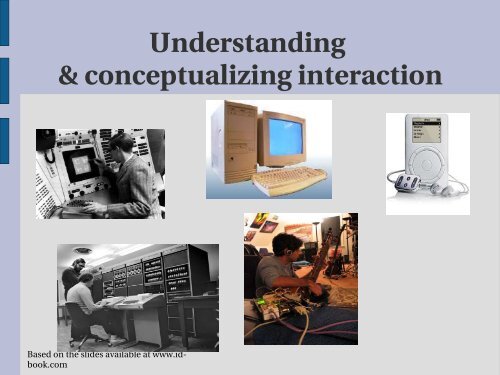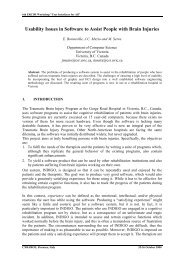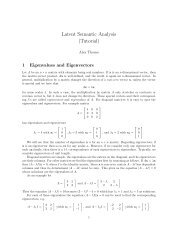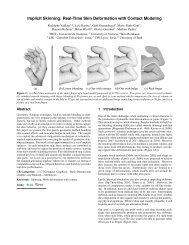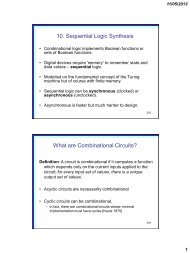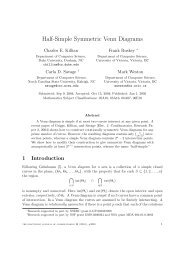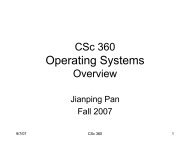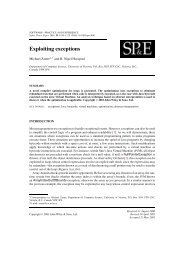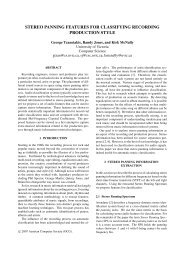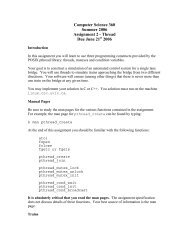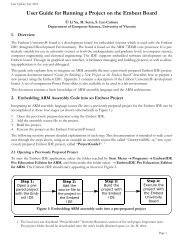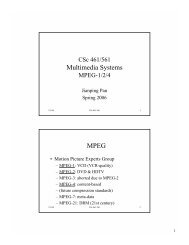Understanding & conceptualizing interaction
Understanding & conceptualizing interaction
Understanding & conceptualizing interaction
Create successful ePaper yourself
Turn your PDF publications into a flip-book with our unique Google optimized e-Paper software.
An example●●●Application to let people organize, store,retrieve email in fast and enjoyable wayThe “wrong” approach– Sketch out how the interface might look– Structure system architecture– Start codingThe ID approach– Ask users about current experiences– Look at existing tools– Why, what and how are you going to design theapplicationBased on the slides available at www.idbook.com
Recap●●●HCI has moved beyond designing interfacesfor desktop machinesAll manner of human activities in allmanner of placesInteraction design– Make work effective, efficient and safer– Improve and enhance learning and training– Provide enjoyable and exciting entertainment– Enhance communication and understanding– Support new forms of creativity and expressionBased on the slides available at www.idbook.com
<strong>Understanding</strong> the problemspace● What do you want to create ?● What are the assumptions ?● Will it achieve what you hope it will ?Based on the slides available at www.idbook.com
A framework for analysing theproblem space● Are there problems with an existingproduct ?● Why do you think there are problems ?● Why do you think your proposed ideasmight be useful ?● How would you see people using it withtheir current way of doing things ?● How will it support people in theiractivities ?● Will it really help them ?Based on the slides available at www.idbook.com
An example● What were the assumptions made by cellphone companies when developing WAP(Wireless application protocol) services ?● Was it a solution looking for a problem ?Based on the slides available at www.idbook.com
Assumptions: realistic orwishlist ?●●●●People want to be kept informed of uptodatenews wherever they are – reasonablePeople want to interact with information onthe move – reasonablePeople are happy using a very small displayand using an extremely restricted interface –not reasonablePeople will be happy doing things on a cellphone they normally do on their PCs –reasonable only for very few usersBased on the slides available at www.idbook.com
From problem space todesign space●●Having a good understanding of theproblem space can help inform the designspace – e.g what kind of interface, behaviorand functionality to provideBut before deciding upon these it isimportant to develop aCONCEPTUAL MODELBased on the slides available at www.idbook.com
Conceptual ModelsThe most important thing to design is the user's conceptual model.Everything else should be subordinated to making that model clera,obvious, and substantial. That is almost exactly the opposite of howmost software is designed. (David Liddle, 1996)HOW WILL USERS UNDERSTAND THE SYSTEM(NOT YOU)Based on the slides available at www.idbook.com
Conceptual Models●Conceptual model– A description of the proposed system in termsof a set of integrated ideas and concepts aboutwhat is should do, behave and look like, that willbe understandable by the user in the mannerintended● Different kinds of conceptual models (thischapter)● Conceptual design (chapter 8)● Activitybased● ObjectbasedInterface metaphorsBased ● on the slides available at www.idbook.com
Conceptual Modelsbased on activities●●●●Giving instructions– Issuing commands using keyboard, functionkeys, selection options via menusConversing– Interacting with the system as if having aconversationManipulating and navigating– Acting on objects and interacting with virtualobjectsExploring and browsing– Finding out and learning thingsBased on the slides available at www.idbook.com
Giving instructions●●●●Where users instruct the system and tell itwhat to do:– e.g tell the time, print a file, connect to networkVery common conceptual model,underlying most devices and systemsQuick and efficient <strong>interaction</strong> especially forrepetitive kinds of actions performed onmultiple objectsForm of commands, syntax, organizationhave been inverstigatedBased on the slides available at www.idbook.com
Conversing●●●●Underlying model of having a conversationwith another humanRange from simple voice recognition menudrivensystem to more complex “naturallanguage” dialoguesExamples = timetables, search engines,advicegiving systemsVirtual agents at the interface– ClippyBased on the slides available at www.idbook.com
Pros and cons ofconversational model●●●Allows users, especially novices andtechnophobes to interact with the system ina way that is familiar– Makes them feel comfortable, less scaredMisunderstandings can arise when thesystem doesn't know how to parse what theuser saysNobody likes to beinterrogatedBased on the slides available at www.idbook.com
Manipulating and Navigating● Involves dragging, selecting, opening,closing and zooming actions on virtualobjects● Exploit's users knowledge of how they moveand manipulate in the physical world● WYSIWYG (what you see is what you get)● DM (direct manipulation)● Shneiderman (1983) cointed the term DM –came from his fascination with computergames at the timeBased on the slides available at www.idbook.com
Direct Manipulation●●●Continuous representation of objects andactions of interestsPhysical actions and button pressinginstead of issuing commands with complexsyntaxRapid reversible actions with immediatefeedback on objects of interestBased on the slides available at www.idbook.com
Why are DM interfaces soenjoyable ?●●●●●●●Novices learn the basic functionality quicklyExperienced users can work extremelyrapidly to carry out a wide range of tasksIntermittent users can retain operationalconcepts over timeError messages rarely neededUsers receive immediate feedbackUsers experience less anxietyGain confidence and mastery feeling incontrolBased on the slides available at www.idbook.com
Disadvantes of DM●●●●●Some people take the metaphor of directmanipulation too literallyNot all tasks can be described by objectsand not all actions can be done directlySome tasks are better achieved throughdelegating – e.g spell checkingScreen space demandingMouse slower than pressing function keysBased on the slides available at www.idbook.com
Exploring and browsing●●Similar to how people browse informationwith existing media (e.g newspapers,magazines, libraries, shops)Information is structured to allow flexibilityin the way the user is able to explore it– Mutlimedia, webBased on the slides available at www.idbook.com
Conceptual models basedon objects●●●Usually based on analogy with something inthe physical worldExamples include books, tools, vehiclesClassic: Star Interface based on officeobjectsBased on the slides available at www.idbook.com
Another classic: thespreadsheet (Bricklin)●●●Analogous to ledger sheetInteractive and computationalEasy to understandBased on the slides available at www.idbook.com
There is no “best” conceptualmodel●●●●DM is good for “doing” types of tasks – e.gdesigning, drawing, flying, drivingInstructions good for repetitive tasksConversation good for children, disabledusers, specialized applicationsHybrid conceptual models are oftenemployed were different ways of carryingout the same actions is supported at theinterface – but take longer to learnBased on the slides available at www.idbook.com
Interface metaphors●●●●Interface designed to be similar to a physicalentity but also has it's own properties– e.g desktop metaphor, web portalsCan be based on activity, object orcombination of bothExploit user's familiar knowledge, helpingthem to understand the unfamiliarConjures up the essence of the unfamiliaractivity, enabling users to leverage of this tounderstand more aspects of the unfamiliarfunctionalityBased on the slides available at www.idbook.com
Benefits of interface metaphors●●●Makes learning of new systems easierHelps users understand the underlyingconceptual modelCan be very innovative and enable therealm of computers and their applicationsto be made more accessible to a greaterdiversity of usersBased on the slides available at www.idbook.com
Problems with interfacemetaphors●●●●●Break conventional and cultural rules– e.g recycle bin placed on desktopCan constrain designers in the way theyconceptualize a problem spaceConflict with design principlesForces users to understand the system interms of metaphorsLimits designer's imagination in coming upwith new conceptual modelsBased on the slides available at www.idbook.com
Conceptual models: from<strong>interaction</strong> mode to style●●Interaction mode:– What the user id doing when interacting with asystem, e.g. Instructing, talking, browsing orotherInteraction style– The kind of interface used to support the mode,e.g. Speech, menubase,d gestureBased on the slides available at www.idbook.com
Many kinds of<strong>interaction</strong> styles● Command● Speech● Dataentry● Form fillin● Query● Graphical● Web● Pen● Augmented reality● Gesture ....Based on the slides available at www.idbook.com
Which <strong>interaction</strong> style tochoose ?● Need to determine requirements and userneeds● Take the budget and other contraints intoaccount● Also will depend on suitability of technologyfor activity being supported● More later (chapter 8)Based on the slides available at www.idbook.com
Interaction paradigms●●●Another form of inspiration for conceptualmodelsFrom the desktop to ubiquitous computing(embedded in the environment)Examples of new paradigms– Ubiguitous computing– Pervasive computing– Tangible bits, augmented reality– Attentive environments– Transparent computing ..Based on the slides available at www.idbook.com
Two examples●●●●●BlueEyes (IBM) – affective computingCooltown (HP) ubiquitous computingVisionary approaches for developing novelconceptual paradigmshttp://www.almaden.ibm.com/cs/BlueEyes/index.htmlhttp://cooltown.hp.com/cooltown/Based on the slides available at www.idbook.com
Summary Points●●●●Important to have a good understanding ofthe problem spaceFundamental aspect of <strong>interaction</strong> design isto develop a conceptual modelInteraction modes and interfacesmetaphors provide a structure for thinkingabout which kind of conceptual model todevelopInteraction styles are specific kinds ofinterfacesInteraction paradigms can also be used●Based on the slides available at www.idbook.com
ViewpointsDESIGN MODELUSER'S MODELSYSTEM MODELBased on the slides available at www.idbook.com
Knowledge in the head and inthe world●●●●Precise behavior from imprecise knowledge– Information in the world– Great precision is not required– Natural constraints are present– Cultural constraints are presentTo remove key gear lever must be in parkpositionDeliberately organize environment tosupport their behaviorTravel through a city without being able todescribe the route preciselyBased on the slides available at www.idbook.com
Knowledge●●●Declarative knowledge : knowledge “of”– Stop at red lights– New York is a big cityProcedural knowledge: knowledge “how”– Perform music– Stop a car with a flat tire on icy road– Play basketball– Difficult to describe largely subconscious– Learned by demonstration/practiceMemory: descriptions that are sufficientlyprecise to work at the time something islearned – French coins exampleBased on the slides available at www.idbook.com
Constraints●●●●●RhymingAlbert Bates Lord – Yugoslavia– Signer recreates poetry on the fly– Homer's Odyssey or Iliad – 27000 lines of verseTaking part and reassembling a mechanicaldevice10 parts – 10! (appr. 3.5 million)Cultural constraints– Screws (clockwise, counterclockwise)Based on the slides available at www.idbook.com
Memory● Shortterm (7+/2)– Automatically – retrieved with no effort●●●●Longterm– Storing and retrieving takes time– Size is not a problem – organization isMemory for arbitrary things – rote learning– Teaching alphabet – use of tune for constraints– When something goes wrong we don't knowwhat to doMemory for meaningful relationshipsMemory through explanationBased on the slides available at www.idbook.com
Reminding●●●●Next Saturday 3:30pm– Keep everything in head– Put it on your calendar– Ask friend/secretary to notify you– Keys in the fridge with lunchboxSignal & message– Tie a string around your finger– Note to yourselfNatural mappings– Stovetops exampleIf a design depends upon labels, it may befaultyBased on the slides available at www.idbook.com


